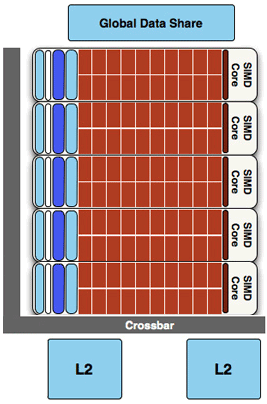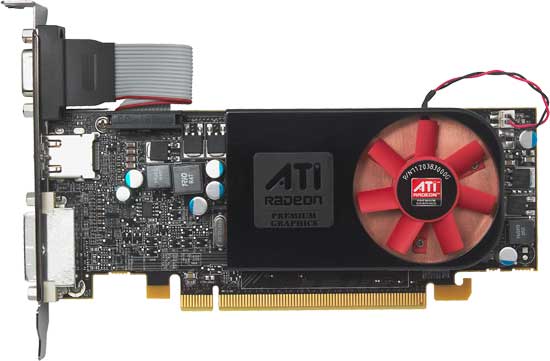AMD’s Radeon HD 5570: Low Profile, Higher Performance
by Ryan Smith on February 9, 2010 12:00 AM EST- Posted in
- GPUs
When AMD launched the 5670, they told us they had 2 more cards on the way: the 5450, and a 5500 series card. Last week we saw the launch of the 5450, utilizing the Cedar GPU and finishing off AMD’s chip stack. Today we’re looking at that 5500 series card, the Radeon HD 5570.
| AMD Radeon HD 5670 | AMD Radeon HD 5570 | AMD Radeon HD 4670 | AMD Radeon HD 5450 | AMD Radeon HD 4550 | |
| Stream Processors | 400 | 400 | 320 | 80 | 80 |
| Texture Units | 20 | 20 | 32 | 8 | 8 |
| ROPs | 8 | 8 | 8 | 4 | 4 |
| Core Clock | 775MHz | 650 | 750MHz | 650MHz | 650MHz |
| Memory Clock | 1000MHz (4000MHz data rate) GDDR5 | 900MHz (1800MHz data rate) DDR3 | 1000MHz (2000MHz data rate) GDDR3 | 800MHz (1600MHz data rate) DDR3 | 800MHz (1600MHz data rate) DDR3 |
| Memory Bus Width | 128-bit | 128-bit | 128-bit | 64-bit | 64-bit |
| Frame Buffer | 1GB / 512MB | 1GB | 1GB / 512MB | 1GB / 512MB | 1GB / 512MB |
| Transistor Count | 627M | 627M | 514M | 292M | 242M |
| TDP | 61W | 42.7W | 59W | 19.1W | 25W |
| Manufacturing Process | TSMC 40nm | TSMC 40nm | TSMC 55nm | TSMC 40nm | TSMC 55nm |
| Price Point | $99 / $119 | $80-$85 | $60-$90 | $49-$59 | $35-$55 |
Right off the bat, the 5570 marks a bit of a departure from AMD’s numbering scheme for the 4000 series. While the Radeon HD 4550 was the faster of the two cards utilizing AMD’s cheapest GPU (RV710), the 5570 is not a faster Cedar card. Instead it’s a slower Redwood card, putting it in the ballpark of the 5670’s rather than the 5450’s.

AMD has done 3 things to differentiate the 5570 from the 5670. The first of which is to significantly castrate the 5670’s memory bandwidth. While the 5670 had 1GHz (4GHz effective) GDD5, the 5570 drops that for simple 900MHz (1.8GHz effective) DDR3, giving the card only 45% of the memory bandwidth of the 5670. The second change is more customary, and that is lowering the core clock from 775MHz to 650MHz, leaving the card with roughly 83% of the computational/rendering/texturing performance of the 5670. None of the SIMDs have been disabled however, so this is a fully functional Redwood GPU.

Finally, in another significant departure from the 4000 series, this is AMD’s second official low-profile video card. For the 4000 series AMD’s only official low-profile card was the 4350, although vendors were known to do low-profile versions of the 4550 (RV710) and the 4650 (RV730). Here AMD is not leaving that up to their vendors, and is doing an official retail low-profile design for their more powerful Redwood GPU. This allows AMD to fill a potential hole in their lineup by offering a low-profile GPU with better than bargain-bin performance.
This card also fills the overall price/performance hole in AMD’s 5000 series lineup, giving them something between the $9 9 5670 and the $50-$60 5450. AMD’s MSRP on this card will be $85, a bit more than half way between the other two cards. Unlike the 5670 and 5450, we’ll only be seeing a single official configuration of the 5570: 1GB of 900MHz DDR3. Our sample comes with 900MHz Samsung chips. It’s also worth noting that this is the same memory configuration as the base Radeon HD 4670, which also used 1GB of 900MHz DDR3.
Between the drop in the core clock and the movement to DDR3, AMD has lopped off nearly 30W from the 5670’s load power usage, bringing the 5570 in at 42.7W. Idle power also drops by nearly 33%, for 9.7W. This low power usage is a big part of why AMD can get away with the 5570 being a low-profile card, as they only need a small single-slot blower to cool the card. The reference cooler (not that we expect many – if any – vendors to use it) is a blower design built upon a copper heatsink, with a small fan blowing air towards the front of the card.

The port configuration is the same as the 5450: 1 VGA, 1 DVI, and 1 smaller digital port. Our sample came with a HDMI port, with vendors free to use an HDMI port or a DisplayPort depending on whether they want Eyefinity support as enabled by using a DisplayPort. As has been the case with all of AMD’s sub-$100 5000 series cards, Eyefinity is still cost-prohibitive at this time due to a lack of cheap active DisplayPort adaptors and monitors offering DisplayPort inputs.
AMD considers NVIDIA’s GT 220 the chief competition for this card. The GT 220 isn’t an official low-profile card, but there are a few models out there in that form factor. In terms of overall pricing, a number of GDDR5 GT 240s can be found at or right below $85, making the GT 240 the closest competitor for this card.










36 Comments
View All Comments
bombacan - Monday, April 5, 2010 - link
when compared to 4670, there is no improvement on neither performance nor power consumption.besides its more expensive and doesn't have a fanless version atm.avhenrik - Saturday, May 15, 2010 - link
I am not a specialist, but check out how rage3d gets smooth deinterlacing with a simpler card (HD 5550) here: http://www.rage3d.com/reviews/video/sapphire_hd555...They combine adaptive vector deinterlacing with other post processing, giving nice results. Have you tried that on the 5570?
hybrid2d4x4 - Thursday, August 26, 2010 - link
It's probably too late to ask this as this article/thread probably never gets checked anymore, but what PSU was used in the review?I'm assuming that it's the standard 750W or higher rated unit that's used for most VGA reviews... but wanted to know how much savings there is to be had by using a low-rated, high-efficiency PSU more suited to a low-power HTPC build.
nfarnham2001 - Monday, December 27, 2010 - link
Okay, I have an HP a6203w desktop with a Bestec 250w PSU. I am looking for an average cheap replacement to the very crappy nvidia 6150se nforce 430 graphics. I am basing my choice off of the fact that video cards without power connectors use the 75 watts of the PCI slot, and since my full system is stock besides 2 more gigs of ram, I figured it could hold it. Professional opinion?dendy - Thursday, July 28, 2011 - link
I was working on the study of the Radeon HD 5570 and NVIDIA GeForce GT 445M for <a href="http://www.bestdealscomputers.net">my blog</a> .... and look for performance comparisons between the two. Is there someone can help?dendy - Thursday, July 28, 2011 - link
http://www.bestdealscomputers.net ... that is my blog.